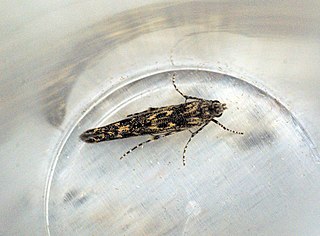
Gelechioidea is the superfamily of moths that contains the case-bearers, twirler moths, and relatives, also simply called curved-horn moths or gelechioid moths. It is a large and poorly understood '"micromoth" superfamily, constituting one of the basal lineages of the Ditrysia.

The Batrachedridae are a small family of tiny moths. These are small, slender moths which rest with their wings wrapped tightly around their bodies.

Batrachedra is the largest genus in the moth family Batrachedridae, with representatives all over the world. The early stages of most species are unknown. The genus name is derived from the Greek words batrachos, 'frog', and edra, 'seat', referring to the frog-like resting posture of the adult moths. As of 2018 at least some 114 species are known to belong to the genus.

Batrachedra praeangusta is a moth of the family Batrachedridae which is native to Europe. It is also found in North America. It was first described by Adrian Haworth in 1828 from the type specimen found in England. The foodplants of the larvae are poplars and willows.

Chedra is a genus of tiny moths, belonging to the family Batrachedridae.
Chedra microstigma is a tiny moth of the family Batrachedridae described in 1907. It has only been found on Oahu. It has been found feeding on sedges, plants belonging to the Cyperaceae family, and its larvae host at least three species of parasitoids in Hawaii.
Chedra mimica is a tiny moth of the family Batrachedridae known from Hawaii.
Ifeda perobtusa is a species of moth of the family Batrachedridae. It is found in Brazil, British Guiana and Peru. Its alar expense is 8-10mm.

Chedra delector is a tiny moth placed in the family Batrachedridae. The Global Lepidoptera Names Index of the Natural History Museum in London classifies it in the family Coleophoridae based on the old classification given by Ron Hodges in the 1983 Check List of the Lepidoptera of America North of Mexico. It is found in Chile. The holotype was collected by D. Bullock on 30 January 1941 at Angol, in the Malleco Province, central Chile, and is kept at the Department of Entomology of the National Museum of Natural History of the Smithsonian Institution. The species was described by Ron Hodges in 1966. The caterpillars feed upon the seeds of Cyperaceae.

Chedra pensor is a tiny dwarf moth in the family Batrachedridae. It was collected by Ronald W. Hodges at a place called West Fork, 16 miles (26 km) southwest of Flagstaff, Coconino County, Arizona, in the United States, at 1,981 metres (6,499 ft) in elevation in early July, and subsequently described by him in 1966. It has been found in the US states of California, Arizona and Illinois. The holotype is kept at the Department of Entomology of the National Museum of Natural History, Smithsonian Institution. It is the type species of the genus Chedra.

Homaledra heptathalama, the exclamation moth or palm leaf housemaker, is a moth in the family Pterolonchidae. It was described by August Busck in 1900. It is found in the United States, where it has been recorded from Alabama, Florida and South Carolina.
Homaledra sabalella, the palm leaf skeletonizer moth, is a moth in the family Pterolonchidae. It is found in North America, where it has been recorded from Alabama, Florida, Mississippi, South Carolina and Texas. It is also present in Puerto Rico, Hispaniola and Cuba.
Batrachedra albicapitella is a moth in the family Batrachedridae. It is found in Russia, Korea and Japan.
Batrachedra elucus is a moth in the family Batrachedridae. It is found in North America, where it has been recorded from Arizona.
Batrachedra enormis, the large batrachedra moth, is a moth in the family Batrachedridae. It is found in Mexico and the southern United States, where it has been recorded from Alabama, Arizona, California, Louisiana, New Mexico and South Carolina.
Batrachedra hypoleuca is a moth in the family Batrachedridae. It is found in Australia.
Batrachedra meator is a moth in the family Batrachedridae. It is found on St. Lucia.
Batrachedra paritor is a moth in the family Batrachedridae. It is found in Jamaica.
Batrachedra testor is a moth in the family Batrachedridae. It is found in North America, where it has been recorded from Florida.
Epimarptidae was a former, or is a possible, monotypic family of moths in the moth superfamily Gelechioidea. It can now be seen as either a synonym of family Batrachedridae, or a monotypic subfamily of that family.





